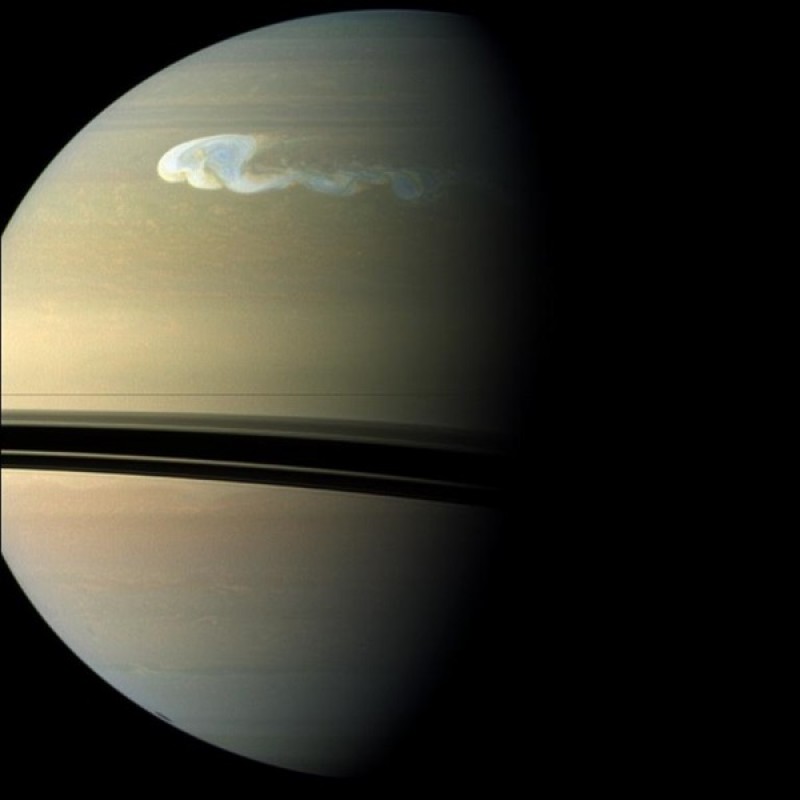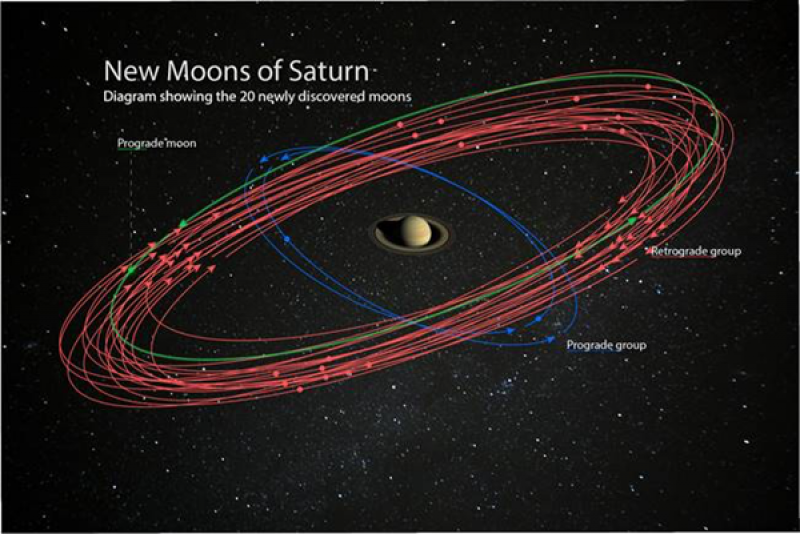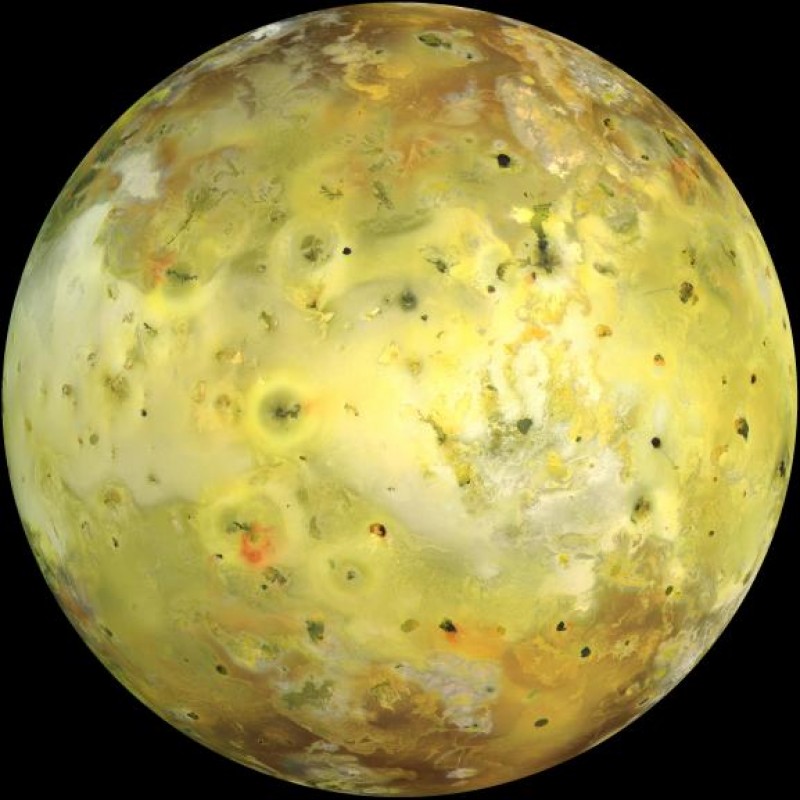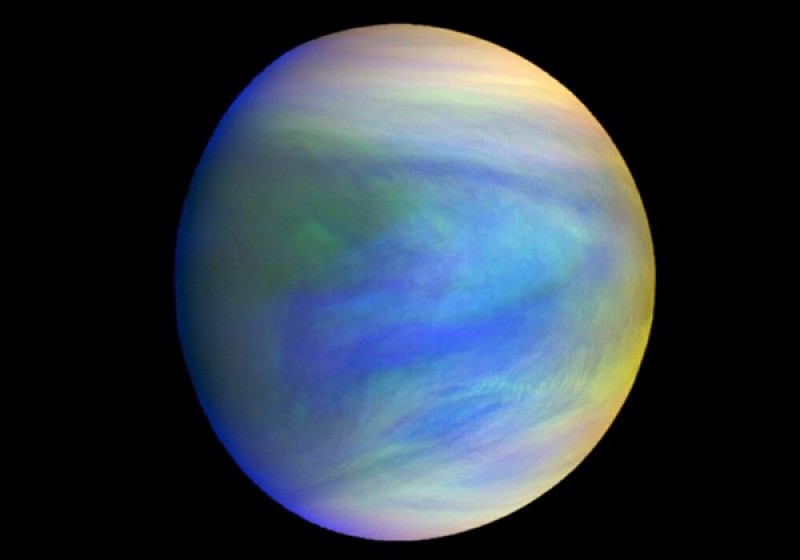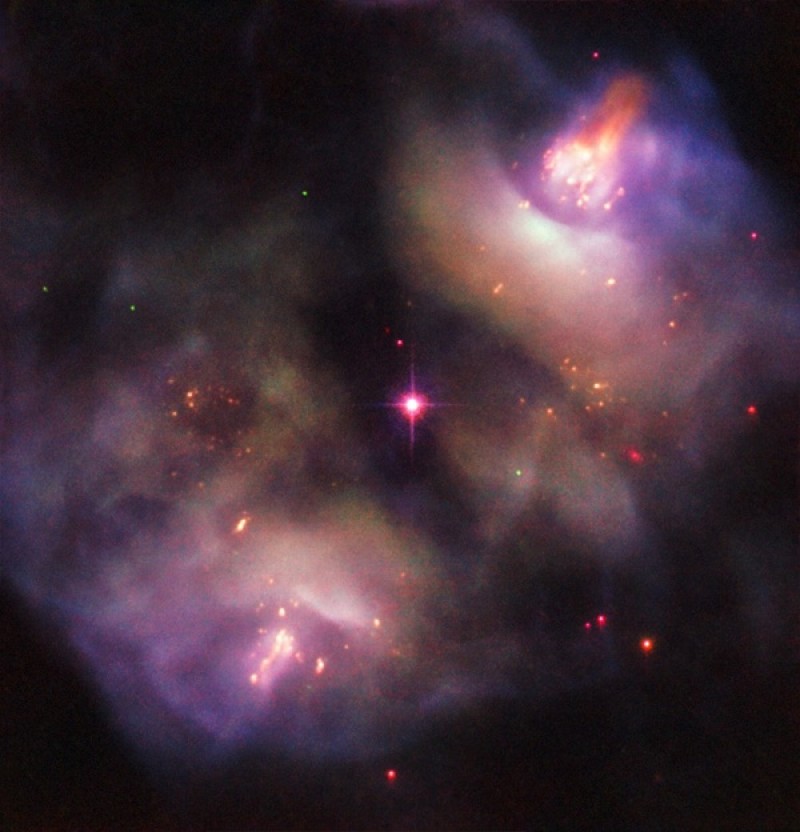News
These colliding galaxies paint a ghostly picture
Thursday, October 31st 2019 11:19 PM
Galaxies in our universe grow and evolve through collisions. When they smash together, galaxies distort and change as gravitational effects spark new star formation and feed supermassive black holes. The entire process can even bind the parties involved into a new, bigger galaxy that may bear no resemblance to the pieces that built it.
Most collisions aren’t head on — but Arp–Madore 2026–424 didn’t get the memo. In June, the Hubble Space Telescope captured a visible-light snapshot of this cosmic smash-up in progress, which has twisted a pair of galaxies into what almost resembles a ghostly face. The central regions, or bulges, of the galaxies involved glow brightly like a pair of supernatural eyes. They appear evenly matched, a sign that the two galaxies are roughly the same size. Gas, dust, and stars that have been yanked the galaxies by the merger now form a huge, bluish ring structure that serves as the head and no...
Read More
Read More
These colliding galaxies paint a ghostly picture
Wednesday, October 30th 2019 11:01 PM
Galaxies in our universe grow and evolve through collisions. When they smash together, galaxies distort and change as gravitational effects spark new star formation and feed supermassive black holes. The entire process can even bind the parties involved into a new, bigger galaxy that may bear no resemblance to the pieces that built it.
Most collisions aren’t head on — but Arp–Madore 2026–424 didn’t get the memo. In June, the Hubble Space Telescope captured a visible-light snapshot of this cosmic smash-up in progress, which has twisted a pair of galaxies into what almost resembles a ghostly face. The central regions, or bulges, of the galaxies involved glow brightly like a pair of supernatural eyes. They appear evenly matched, a sign that the two galaxies are roughly the same size. Gas, dust, and stars that have been yanked the galaxies by the merger now form a huge, bluish ring structure that serves as the head and nose...
Read More
Read More
This monster galaxy made stars hundreds of times faster than the Milky Way
Tuesday, October 29th 2019 10:58 PM
Our universe’s history began about 13.8 billion years ago with the Big Bang. When astronomers probe deep into space, they see parts of the universe as they were early in this history. That’s because it takes light a long time to travel vast distances. To find out how galaxies formed and evolved over time, astronomers look for the oldest, most distant objects they can see.These observations reveal that massive galaxies appeared in the universe as early as 1 billion or 2 billion years after the Big Bang. But how were there already enough stars to make such large galaxies? The findings imply that early massive galaxies must have formed stars at incredibly high rates.
Now, a team of astronomers has spotted one of these early galaxies in the act of churning out stars. Their observations capture the galaxy, which is about the size of the Milky Way, as it was about 1 billion years after the Big Bang. However, the galaxy is creating roughly 300 Suns&rsq...
Read More
Read More
A new kind of storm appears on Saturn, puzzling astronomers
Thursday, October 24th 2019 04:19 PM
As serene as it appears in photographs, the gas giant Saturn is not a peaceful place. Its golden gases whiz around the planet at up to a thousand miles per hour. At times, massive storms thousands of miles wide break out in its upper atmosphere.In 2018, astronomers spotted a new kind of storm on Saturn. Four large tempests formed one after another, passing by each other and further disturbing the atmosphere to create a complex storm system that lasted months.
Computer models let the researchers estimate the energy behind the event and compare it to other storms on Saturn. Studying these phenomena in more detail may let astronomers better understand the complex behaviors of the giant planet’s atmosphere. A team of scientists from Spain, Australia, the U.S. and France presented the research Monday in Nature Astronomy.
A New Kind of Storm
The researchers first noticed the new storms in photographs that amateur astronomers had taken...
Read More
Read More
20 new moons discovered orbiting Saturn
Tuesday, October 15th 2019 04:47 PM
Astronomers have found 20 new moons orbiting Saturn, bumping its total up to 82 moons. That surpasses Jupiter, which was the prior reigning champion with 79 moons.
One of the new moons has the farthest known orbit around Saturn, and all are similar in size, with diameters around three miles (5 kilometers). Two of the moons take about two years to orbit, while the other 18 take more than three years to do so.
Seventeen of the new moons orbit Saturn backward — or in retrograde — compared to the planet's other natural satellites. The retrograde moons have orbits resembling some of Saturn's other already-known moons. And by looking at their inclinations, astronomers suspect these moons could have been part of a much larger moon that broke apart long ago.
The moons were discovered by a team led by Scott S. Sheppard at the Carnegie Institution for Science and using the Subaru Telescope on Hawaii’s Mauna Kea.
By studyi...
Read More
Read More
Giant volcano on Jupiter's moon Io could erupt any second
Tuesday, September 24th 2019 05:55 PM
A volcano spread across an area greater than Lake Michigan could erupt any day. Located on Jupiter’s moon Io scientists predict that Loki, named after the Norse trickster god, is due to explode sometime in mid-September. The volcano last erupted in May 2018, an event also predicted by scientists.
“Loki volcano is huge — 200 kilometers across. It’s large enough that it would completely take out southern California if it were on Earth,” said Julie Rathbun, a scientist at the Planetary Science Institute in Tucson, Arizona. She presented the prediction in a poster at the European Planetary Science Congress-Division for Planetary Sciences meeting in Geneva on September 17.
“It is also a different kind of volcano. …The lavas on Io are much thinner and runnier, more like lavas in Hawaii and they don’t build tall mountains. Instead, you can think of Loki more like a giant hole in the ground filled with molten lava.&rd...
Read More
Read More
Water found in habitable super-Earth's atmosphere for first time
Thursday, September 12th 2019 06:32 PM
Astronomers have finally uncovered water vapor in the atmosphere of a super-Earth exoplanet orbiting within the habitable zone of its star. The find means that liquid water could also exist on the rocky world's surface, potentially even forming a global ocean.
The discovery, made with NASA's Hubble Space Telescope, serves as the first detection of water vapor in the atmosphere of such a planet. And because the planet, dubbed K2-18 b, likely sports a temperature similar to Earth, the newfound water vapor makes the world one of the most promising candidates for follow-up studies with next-generation space telescopes.
"This is the only planet right now that we know outside the solar system that has the correct temperature to support water, it has an atmosphere, and it has water in it, making this planet the best candidate for habitability that we know right now," lead author Angelos Tsiaras, an astronomer at University College London, said in a press confer...
Read More
Read More
Giant bubbles spotted rushing out from Milky Way’s center
Thursday, September 12th 2019 06:29 PM
The Milky Way is blowing bubbles. Two giant radio bubbles, extending out from the galaxy for over 1,400 light years, were just discovered in X-ray data. Astronomers think the bubbles started forming a few million years ago due to some type of cataclysmic event near the galaxy’s central supermassive black hole.
The bubbles’ location also closely matches the range of over 100 narrow, magnetized filaments of radio emissions that stretch for tens of light years in length. First discovered 35 years ago, these filaments’ origins have remained a mystery, but the bubbles’ discovery may now provide an answer.
“The filaments have been a mystery for a long time,” said Ian Heywood, astronomer at the University of Oxford and lead author on the new discovery. He says their results hint that the event that created the bubbles could have also produced high-energy charged particles that created the filaments. The symmetry of the...
Read More
Read More
Mysterious dark patches in Venus’ clouds are affecting the weather there
Friday, August 30th 2019 09:04 PM
Something mysterious swirls amidst the clouds of Venus.The planet’s hot, harsh atmosphere is thick with carbon dioxide and sulfuric acid. Atmospheric gases circulate amid cloud layers according to patterns that scientists don’t fully understand. And Venusian clouds also contain strange, dark patches, called “unknown absorbers” because they absorb large amounts of solar radiation.No one has yet determined what these dark patches are, but scientists have speculated that they might be forms of sulfur, ferric chloride or even microscopic life.Now, a team of scientists led by Yeon Joo Lee, a researcher in the Center for Astronomy and Astrophysics at the Technical University of Berlin, has shown that the unknown absorbers are affecting Venus’s weather.
On Venus, as on Earth, the energy that drives the atmosphere’s winds comes from the Sun. By studying more than a decade of data from Venus Express, Akatsuki, Messenger and the Hubble Space Telescope, the re...
Read More
Read More
A star is dead: Hubble sees aftermath of a sun's death
Thursday, August 29th 2019 08:04 PM
Over in the Gemini constellation, the Hubble Space Telescope has captured a new image of the remnants of a dying star system called NGC 2371/2.At first, astronomers thought the dying star system was two objects instead of just one. The planetary nebula -- a shell of gasses surrounding the star -- has a symmetrical structure that makes it look like two suns died. You can see that duality in the upper left and the lower right on the photo. NGC 2371/2 consists of a Sun-like star, which blasted off its outer layers after its death. The outer layers pushed out into space, leaving behind the star’s hot remains. And the entire system glows as the dying star’s radiation interacts with galactic dust. Eventually this star will cool, forming a white dwarf, and the lobes will dissipate completely. One day, our own Sun is fated to turn into a dying white dwarf as well.
Read More
Read More



